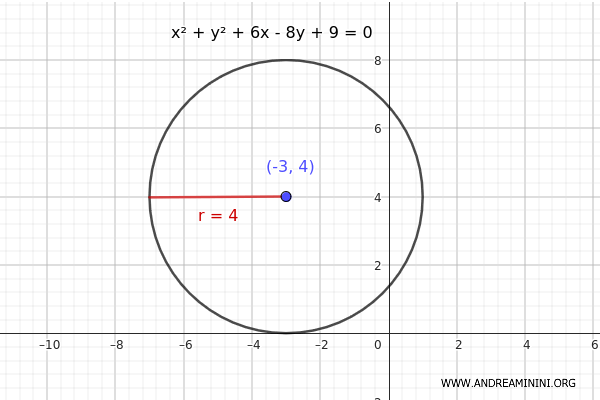Formula for the Center of a Circle
To find the coordinates (x, y) of the center of a circle from its general equation $$ x^2 + y^2 + Dx + Ey + F = 0 $$, you can use the following formula: $$ O(x, y) = \left( -\frac{D}{2}, -\frac{E}{2} \right) $$
When the equation of the circle is written in standard form
\[ (x - h)^2 + (y - k)^2 = r^2 \]
The center and radius of the circle on the Cartesian plane are much more obvious:
- \( (h, k) \) are the coordinates of the center of the circle
- \( r \) is the radius of the circle.
If the circle's equation is in general form:
\[ x^2 + y^2 + Dx + Ey + F = 0 \]
You can find the center \((h, k)\) using these formulas:
$$ h = -\frac{D}{2} $$
$$ k = -\frac{E}{2} $$
In these formulas, \(D\) and \(E\) are the coefficients of the \(x\) and \(y\) terms in the general equation $ x^2 + y^2 + Dx + Ey + F = 0 $ of the circle.
Therefore, the center of the circle is given by the coordinates \((-D/2, -E/2)\).
Note: Alternatively, you can find the coordinates of the center by transforming the general equation of the circle $ x^2 + y^2 + Dx + Ey + F = 0 $ into the standard form $ (x - h)^2 + (y - k)^2 = r^2 $ by completing the square and adding the necessary terms.
An Example
Let's go through a practical example to clarify the process.
Given the general equation of a circle:
\[ x^2 + y^2 + 6x - 8y + 9 = 0 \]
To find the center of the circle, identify the coefficients \(D\) and \(E\) in the equation. In this case, they are:
$$ D = 6 $$
$$ E = -8 $$
Use the formulas to find the coordinates \(h\) and \(k\) of the center of the circle:
$$ h = -\frac{D}{2} = -\frac{6}{2} = -3 $$
$$ k = -\frac{E}{2} = -\frac{-8}{2} = 4 $$
Therefore, the center of the circle is \((-3, 4)\).

The Proof
To demonstrate how to derive the center of the circle from the general equation \( x^2 + y^2 + Dx + Ey + F = 0 \), we need to transform the equation into the standard form \((x - h)^2 + (y - k)^2 = r^2\).
Consider the general equation of a circle:
$$ x^2 + y^2 + Dx + Ey + F = 0 $$
Group the \(x\) and \(y\) terms:
$$ (x^2 + Dx) + (y^2 + Ey) + F = 0 $$
Complete the square for the \(x\) terms by adding and subtracting $ \left(\frac{D}{2}\right)^2 $:
$$ (x^2 + Dx + \left(\frac{D}{2}\right)^2) - \left(\frac{D}{2}\right)^2 + (y^2 + Ey) + F = 0 $$
$$ (x + \frac{D}{2})^2 - \left(\frac{D}{2}\right)^2 + (y^2 + Ey) + F = 0 $$
Complete the square for the \(y\) terms by adding and subtracting $ \left(\frac{E}{2}\right)^2 $:
$$ \left(x + \frac{D}{2}\right)^2 - \left(\frac{D}{2}\right)^2 + (y^2 + Ey + \left(\frac{E}{2}\right)^2) - \left(\frac{E}{2}\right)^2 + F = 0 $$
$$ \left(x + \frac{D}{2}\right)^2 - \left(\frac{D}{2}\right)^2 + \left(y + \frac{E}{2}\right)^2 - \left(\frac{E}{2}\right)^2 + F = 0 $$
Reorganize the terms:
$$ \left(x + \frac{D}{2}\right)^2 + \left(y + \frac{E}{2}\right)^2 = \left(\frac{D}{2}\right)^2 + \left(\frac{E}{2}\right)^2 - F $$
This gives the standard equation of the circle \((x - h)^2 + (y - k)^2 = r^2\), where:
$$ h = -\frac{D}{2} $$
$$ k = -\frac{E}{2} $$
Therefore, the center of the circle \((h, k)\) is:
$$ \left(-\frac{D}{2}, -\frac{E}{2}\right) $$
And the radius \(r\) is:
$$ r = \sqrt{\left(\frac{D}{2}\right)^2 + \left(\frac{E}{2}\right)^2 - F} $$
This proves the formula for finding the center and radius of a circle when the equation is in general form.
And so on.
